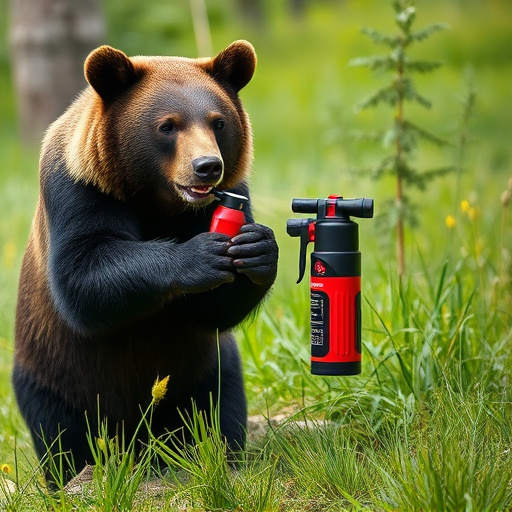Bear spray, with its higher capsaicin concentration (15-20%) compared to regular pepper spray (1-2%), is a more effective deterrent against aggressive bears. It temporarily blinds and disorients them within a 30-foot range. While bear spray's strength lies in targeting bears' sensory organs, standard pepper spray can be potent at closer ranges (4-6 feet). Both offer immediate pain relief but the optimal choice depends on specific conditions and user technique.
“Bear spray, a potent deterrent, has become an essential tool for outdoor enthusiasts navigating treacherous terrain. This article delves into the effectiveness of bear spray as a protective measure, exploring its chemical composition and functionality. We dissect the science behind deterrent ranges, uncovering factors that dictate success.
Furthermore, we compare bear spray to pepper spray, analyzing strength dynamics to provide insights on which is superior in real-world scenarios. Understanding these nuances is crucial for choosing the right self-defense option in wild environments.”
- Understanding Bear Spray: The Chemical Composition and Its Functionality
- The Science Behind Effective Deterrent Ranges: What Factors Determine Success?
- Comparatively Analyzing Bear Spray vs Pepper Spray: Unraveling the Strength Dynamics
Understanding Bear Spray: The Chemical Composition and Its Functionality
Bear spray, also known as bear repellent, is a specialized aerosol designed to deter and protect users from aggressive bears. Unlike traditional pepper spray used for human self-defense, bear spray targets the bear’s sensory organs, specifically its eyes, nose, and mouth, temporarily blinding and disorienting it. The primary active ingredient in most bear sprays is capsaicin, derived from chili peppers, which is known for its pungent and irritant properties. This chemical composition makes bear spray highly effective against various bear species, including grizzly bears and black bears.
When considering the effectiveness of bear spray compared to regular pepper spray, it’s evident that bear spray is tailored to the unique challenges posed by wild bears. While standard pepper spray can be powerful, its range and impact on large animals like bears are limited. Bear spray, however, offers a much greater range—typically up to 30 feet (9 meters)—and its higher concentration of capsaicin ensures a more significant reaction from bears. This makes bear spray a superior deterrent for outdoor enthusiasts and individuals living in bear country, providing them with a crucial tool for self-defense against these powerful predators.
The Science Behind Effective Deterrent Ranges: What Factors Determine Success?
The effectiveness of bear spray as a deterrent is grounded in science, with several factors influencing its success range. One key aspect is concentration—the higher the capsaicin (the active ingredient) content, the greater the potential to deter bears. In terms of comparison, bear spray typically contains 15-20% capsaicin, which significantly surpasses the concentration found in standard pepper spray designed for human self-defense (usually around 1-2%). This higher concentration makes bear spray a stronger deterrent against aggressive bears.
Other determinants include weather conditions and environmental factors. For instance, wind direction plays a crucial role; spraying bear spray into the face of an approaching bear with a tailwind can reduce its effectiveness due to the capsaicin being blown away. Additionally, temperature affects aerosol dispersion; in colder temperatures, bear spray tends to stay airborne longer, increasing its range and impact. Moisture levels and humidity also influence how far the spray travels and how well it sticks to the bear’s fur or skin.
Comparatively Analyzing Bear Spray vs Pepper Spray: Unraveling the Strength Dynamics
When comparing bear spray to pepper spray, understanding their respective strengths is crucial for choosing the right self-defense tool in potential wildlife encounters. Many believe bear spray is inherently stronger due to its specific formulation designed for repelling bears. However, pepper spray—a broader term referring to a range of capsaicin-based irritants—also boasts significant potency and can be equally effective against various threats, not just bears.
While bear spray’s manufacturer claims typically advertise ranges up to 30 feet (9 meters), pepper spray can be effective even at shorter distances, often around 4 to 6 feet (1.2 to 1.8 meters). This difference in declared range doesn’t necessarily translate into one spray being universally stronger; it depends on factors like the user’s technique, weather conditions, and the specific product’s concentration. In terms of intensity, pepper spray can deliver a powerful punch, causing immediate pain, temporary blindness, and difficulty breathing—effects that can be just as deterring in close-quarters encounters.
Bear spray, while often touted as a primary defense against bears, is most effective within a specific range. Understanding both its chemical composition and the science behind deterrent ranges is key to knowing whether it’s stronger than pepper spray or not. Comparatively, pepper spray offers a different strength dynamic, making informed choices crucial for safety in potential wildlife encounters. Remember that knowledge of usage, proper application, and awareness of environmental factors are vital to ensure effectiveness.
